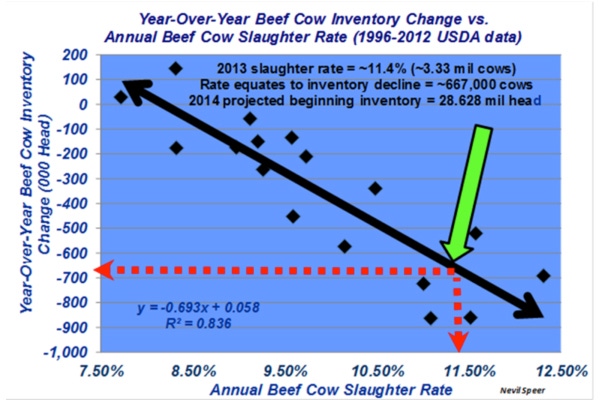Are we on pace for fewer cows next year?
September 19, 2013

Last week’s Industry-At-A-Glance chart focused primarily on the annual beef cow slaughter rate, measured as a percentage of the beginning inventory. That rate obviously plays an important role in determining the size of next year’s beef cow inventory.
That influence is two-fold. First, the direct influence is straight-forward: more cows slaughtered means fewer cows retained. But, secondly, the rate also serves as an indirect indicator of the aggregate intention to rebuild the cowherd. Higher slaughter rates also mean fewer cows being kept back that might otherwise be retained if producers intend to collective grow the cowherd.
As noted in last week’s discussion, beef cow slaughter through the first half of 2013 has equaled approximately 1.6 million head. That’s equivalent to 5.45% of 2013’s starting head count. Meanwhile, during the past 10 years, the average slaughter rate during the second half of the year increases by nearly a half percentage point compared to the first half of the year. If that relationship holds in 2013, it’s likely that beef cow slaughter rate will be nearly 6% between July and December.

Given these trends, it appears that 2013 is on pace to see the slaughter of about 11.4% of its starting cow inventory – a pace that would be equivalent to 3.33 million cows. Based on annual data since 1996, that rate would translate to a decline in beef cow inventory of approximately 667,000 cows. That pace would place next year’s starting inventory around 28.63 million beef cows.
Amidst discussions with producers, where do you see this trend headed? Are we on pace for fewer cows next year? Is there any desire out in the country to begin rebuilding in the near future? And if not, how low might we go with cow numbers in the U.S.? No matter the answer, the implications are huge! Leave your thoughts below.
You might also like:
Rebuilding Your Herd, At What Cost?
Ranching Generations Working Together
BEEF 50: Meet Top Industry Leaders
Feed Composition Tables: Nutrient Values For 300 Cattle Feeds
About the Author(s)
You May Also Like





